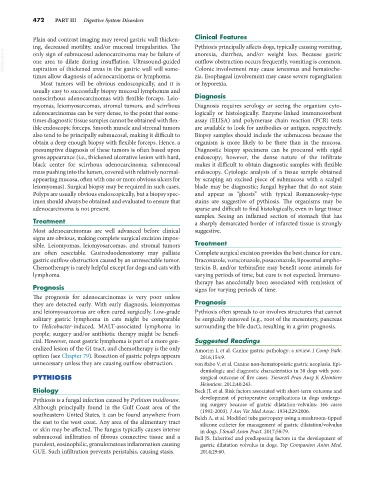Page 500 - Small Animal Internal Medicine, 6th Edition
P. 500
472 PART III Digestive System Disorders
Plain and contrast imaging may reveal gastric wall thicken- Clinical Features
ing, decreased motility, and/or mucosal irregularities. The Pythiosis principally affects dogs, typically causing vomiting,
VetBooks.ir only sign of submucosal adenocarcinoma may be failure of outflow obstruction occurs frequently, vomiting is common.
anorexia, diarrhea, and/or weight loss. Because gastric
one area to dilate during insufflation. Ultrasound-guided
Colonic involvement may cause tenesmus and hematoche-
aspiration of thickened areas in the gastric wall will some-
times allow diagnosis of adenocarcinoma or lymphoma. zia. Esophageal involvement may cause severe regurgitation
Most tumors will be obvious endoscopically, and it is or hyporexia.
usually easy to successfully biopsy mucosal lymphomas and
nonscirrhous adenocarcinomas with flexible forceps. Leio- Diagnosis
myomas, leiomyosarcomas, stromal tumors, and scirrhous Diagnosis requires serology or seeing the organism cyto-
adenocarcinomas can be very dense, to the point that some- logically or histologically. Enzyme-linked immunosorbent
times diagnostic tissue samples cannot be obtained with flex- assay (ELISA) and polymerase chain reaction (PCR) tests
ible endoscopic forceps. Smooth muscle and stromal tumors are available to look for antibodies or antigen, respectively.
also tend to be principally submucosal, making it difficult to Biopsy samples should include the submucosa because the
obtain a deep enough biopsy with flexible forceps. Hence, a organism is more likely to be there than in the mucosa.
presumptive diagnosis of these tumors is often based upon Diagnostic biopsy specimens can be procured with rigid
gross appearance (i.e., thickened ulcerative lesion with hard, endoscopy; however, the dense nature of the infiltrate
black center for scirrhous adenocarcinoma; submucosal makes it difficult to obtain diagnostic samples with flexible
mass pushing into the lumen, covered with relatively normal- endoscopy. Cytologic analysis of a tissue sample obtained
appearing mucosa, often with one or more obvious ulcers for by scraping an excised piece of submucosa with a scalpel
leiomyomas). Surgical biopsy may be required in such cases. blade may be diagnostic; fungal hyphae that do not stain
Polyps are usually obvious endoscopically, but a biopsy spec- and appear as “ghosts” with typical Romanowsky-type
imen should always be obtained and evaluated to ensure that stains are suggestive of pythiosis. The organisms may be
adenocarcinoma is not present. sparse and difficult to find histologically, even in large tissue
samples. Seeing an inflamed section of stomach that has
Treatment a sharply demarcated border of infarcted tissue is strongly
Most adenocarcinomas are well advanced before clinical suggestive.
signs are obvious, making complete surgical excision impos-
sible. Leiomyomas, leiomyosarcomas, and stromal tumors Treatment
are often resectable. Gastroduodenostomy may palliate Complete surgical excision provides the best chance for cure.
gastric outflow obstruction caused by an unresectable tumor. Itraconazole, voraconazole, posaconazole, liposomal ampho-
Chemotherapy is rarely helpful except for dogs and cats with tericin B, and/or terbinafine may benefit some animals for
lymphoma. varying periods of time, but cure is not expected. Immuno-
therapy has anecdotally been associated with remission of
Prognosis signs for varying periods of time.
The prognosis for adenocarcinomas is very poor unless
they are detected early. With early diagnosis, leiomyomas Prognosis
and leiomyosarcomas are often cured surgically. Low-grade Pythiosis often spreads to or involves structures that cannot
solitary gastric lymphoma in cats might be comparable be surgically removed (e.g., root of the mesentery, pancreas
to Helicobacter-induced, MALT-associated lymphoma in surrounding the bile duct), resulting in a grim prognosis.
people; surgery and/or antibiotic therapy might be benefi-
cial. However, most gastric lymphoma is part of a more gen- Suggested Readings
eralized lesion of the GI tract, and chemotherapy is the only Amorim I, et al. Canine gastric pathology: a review. J Comp Path.
option (see Chapter 79). Resection of gastric polyps appears 2016;154:9.
unnecessary unless they are causing outflow obstruction. von Babo V, et al. Canine non-hematopoietic gastric neoplasia. Epi-
demiologic and diagnostic characteristics in 38 dogs with post-
PYTHIOSIS surgical outcome of five cases. Tierarztl Prax Ausg K Kleintiere
Heimtiere. 2012;40:243.
Etiology Beck JJ, et al. Risk factors associated with short-term outcome and
Pythiosis is a fungal infection caused by Pythium insidiosum. development of perioperative complications in dogs undergo-
Although principally found in the Gulf Coast area of the ing surgery because of gastric dilatation-volvulus: 166 cases
(1992-2003). J Am Vet Med Assoc. 1934;229:2006.
southeastern United States, it can be found anywhere from Belch A, et al. Modified tube gastropexy using a mushroom-tipped
the east to the west coast. Any area of the alimentary tract silicone catheter for management of gastric dilatation/volvulus
or skin may be affected. The fungus typically causes intense in dogs. J Small Anim Pract. 2017;58:79.
submucosal infiltration of fibrous connective tissue and a Bell JS. Inherited and predisposing factors in the development of
purulent, eosinophilic, granulomatous inflammation causing gastric dilatation volvulus in dogs. Top Companion Anim Med.
GUE. Such infiltration prevents peristalsis, causing stasis. 2014;29:60.

